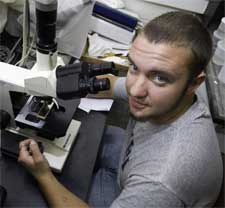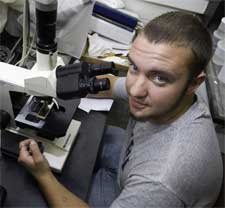 URI junior helps restore oyster beds
URI junior helps restore oyster beds
KINGSTON, R.I. – November 24, 2008 — A University of Rhode Island junior who comes from a long line of fishermen is playing a key role in helping the state’s fishermen recover from a devastating oil spill 12 years ago.
Patrick Shepard, who hails from the small island of Stonington in Maine, is using his knowledge in marine affairs to help restore the shellfish population damaged in 1996 by an oil spill caused by the North Cape grounding off East Matunuck State Beach.
Having lived on the coast his entire life, Shepard appreciates the unique opportunity that URI’s Coastal Fellows program has given him. “I chose the North Cape project because commercially viable shellfish populations are being depleted throughout the Northeast due to overfishing, habitat degradation, and pollution, so it is crucial that we learn how to rebuild and sustain a better population of shellfish,” Shepard said.
Directed by the National Oceanic and Atmospheric Administration and the Rhode Island Department of Environmental Management, the project aims to enhance and restore shellfish populations that were damaged when the tug barge, North Cape, ran aground. The project focuses on three main types of shellfish — the quahog, scallop and oyster. Shepard is focusing his work on the oyster population.
His mentor is Bryan DeAngelis, lobster and shellfish project coordinator with NOAA Fisheries. “Bryan is an outstanding and very intelligent person. He is very knowledgeable in shellfish recruitment methods and he is very good at handing down that knowledge to those who work under him,” Shepard said.
Shepard’s work with the project began last May when he worked in East Matunuck, R.I. gathering data on oyster development and recruitment at two restoration sites in Point Judith Pond.
Twice a week for much of the summer months, Shepard collected concentrated water samples to learn more about the eastern oyster’s reproductive development and its peak spawning time. Shepard also checked oyster recruitment in “spat condos,” which are false habitats put into the water. “They are a place for the oysters to attach themselves and grow,” said the URI student.
After months of collecting data and research, Shepard is completing the final phase of his project. He has been analyzing the samples he collected with hopes of making correlations with certain characteristics that may explain what causes a peak in spawning of the eastern shellfish.
“I hope to be able to take what I have learned from this project and be able to help other regions that are experiencing similar problems,” Shepard said. He hopes that his sharpened environmental skills will benefit that small Maine community when he returns home, where the shellfish are being overfished.
With less than two more years left at URI, his plans for the future often change when he learns about new opportunities and advancements. “I hope to join NOAA corps, a uniformed service of the United States. Someday I hope to work for the national government in fisheries management.”
NOAA offers opportunities to travel the oceans working and studying fisheries management. Its mission is to manage marine resources to meet the nation’s economic, social and environmental needs. Shepard also hopes to spend a semester studying in Fairbanks, Alaska.
Shepard’s research as been funded by the URI Coastal Fellows Program, a unique program designed to involve undergraduate students in addressing environmental problems. The program teams students with faculty, research staff and graduate students to help them gain skills that will ensure their future success.
Pictured above
Patrick Shepard. URI Department of Communications & Marketing photo by Michael Salerno Photography.

